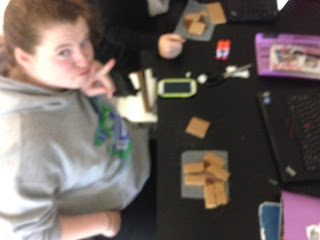This is a chronicle of teaching Earth System Science and Educational Technology at NMU. http://www.nmu.edu
Friday, November 22, 2013
Plate tectonics Models and Foldables
http://www.ig.utexas.edu/research/projects/plates/
Plate tectonics is a powerful tool for reconstructing (i.e. "predicting") geological environments through geologic history, particularly if the underlying plate motion model is accurate and detailed. PLATES tools are especially useful to groups engaged in exploration for hydrocarbons or minerals on global and regional scales. PLATES reconstructions provide a solid framework on which to build detailed geological models, such as basin response to regional crustal motion, likely sequences of depositional paleo-environment, or probable geothermal consequences of plate position or movement.
PLATES maintains an up-to-date oceanic magnetic and tectonic database, continuously adding new paleomagnetic, hot spot, geological and geophysical data to extend the span and accuracy of global plate reconstructions. PLATES' reconstructions are built around a comprehensive database of finite-difference poles of rotation, derived both from extensive plate motion research at UTIG, using the PLATES interactive plate modeling software, and from published studies. Updated plate motion models are in turn applied to regional tectonic studies by PLATES investigators and collaborators and by project sponsors. The plate model developed by the PLATES Project describes the evolution of the earth's oceans and the movement of the earth's tectonic plates from the Late Precambrian through the present day
http://www.google.com/url?sa=t&rct=j&q=&esrc=s&frm=1&source=web&cd=1&ved=0CCwQFjAA&url=http%3A%2F%2Fwww.iris.edu%2Fhq%2Ffiles%2Fprograms%2Feducation_and_outreach%2Faotm%2F2%2FFoamFaultModel_Activity.pdf&ei=882PUuKWKKGI2wXFyIDwBA&usg=AFQjCNFGN9KsnIaco2OqcQIWsWJuJ2aVHw&sig2=NJmp-181D0S17OZL6jCtRA&bvm=bv.56988011,d.b2I&cad=rjt
http://conceptvault1.wikispaces.com/Plate+Tectonics
Wednesday, November 20, 2013
UNAVCO
Mission Statement
UNAVCO, a non-profit university-governed consortium, facilitates geoscience research and education using geodesy.We challenge ourselves to transform human understanding of the changing Earth by enabling the integration of innovative technologies, open geodetic observations, and research, from pole to pole.
Learning
UNAVCO promotes a broader understanding of Earth science. We collaborate with
scientific and educational partners to increase the number and diversity of the
next generation of Earth science students. UNAVCO provides many learning
opportunities including: Short Courses and Workshops, Educational
Resources, RESESS Research Student Internships, and Technical
Training.
Friday, November 15, 2013
Contiental Drift and Plate Tectonics
http://www.windows2universe.org/teacher_resources/teach_snacktectonics.html
DIRECTIONS:
1.Make the model
a.Give each student about a square foot of wax paper and a large dollop of frosting. Instruct students to spread frosting into a layer about half a cm thick.
b.Tell students that the frosting in this model represents the asthenosphere, the viscous layer on which Earth's plates ride. The plates in this model are represented by fruit roll up (oceanic crust which is thin and dense) and graham crackers (continental crust which is thick but less dense).
2.Divergent plate boundary
a.Instruct students to place the two squares of fruit roll up (oceanic plates) onto the frosting right next to each other.
b.Press down slowly on the fruit roll ups (because they are dense and will sink a bit into the asthenosphere) as you slowly push them apart about half a cm.
c.Notice how the frosting is exposed and pushed up where the plates are separated? This is analogous to how magma comes to the surface where real plates are moving apart at divergent plate boundaries. Most divergent plates boundaries are located within oceanic crust. When plates begin to pull apart at continents, rift valleys are made, like the great rift valley in Africa, which can become the bottom of the sea floor if the plates continue to pull apart.
3.Transform plate boundaries
a.Pick the two crackers up off the frosting and turn them around so that two dry edges are next to each other.
b.Push one cracker past the other to simulate a transform plate boundary like the San Andreas fault!
Friday, November 1, 2013
Subscribe to:
Comments (Atom)

































